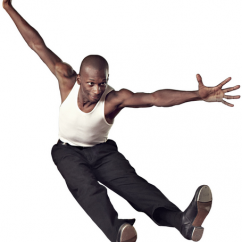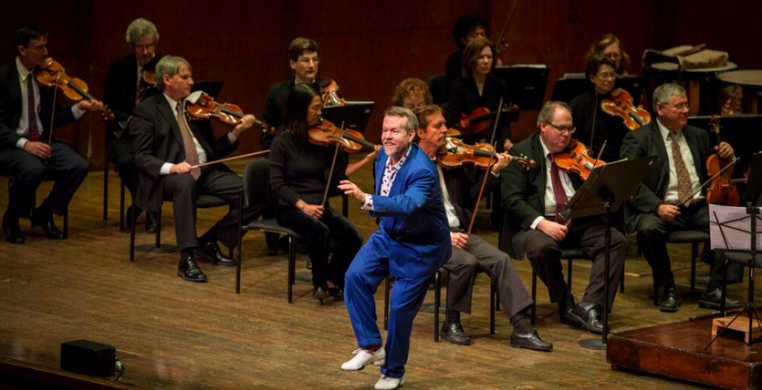The packed Museum of Contemporary Art’s Edlis Neeson Theatre buzzed with anticipation as ardent tap dance devotees, dancers of all stripes, and a veritable who’s who of Chicago dance philanthropy awaited Tommy Tune’s performance of “Taps, Tunes, and Tall Tales,” his memoir in song and dance.
“I’m farklemt,” came a woman’s voice next to me. The 25th Anniversary Gala of The Chicago Human Rhythm Project was hardly an occasion where I expected to hear Yiddish, and I looked up from my program to encounter none other than the great Diane “Lady Di” Walker, one of America’s finest masters of tap, and an icon of “Rhythm World,” CHRP’s annual international tap and percussive dance festival, for the past 25 years.
“Farklemt,” which means “emotionally moved,” is exactly the universal state of being this extraordinary weekend of performances has inspired in CHRP’s audiences. From Tommy Tune’s abundant capacity for conveying his love for life through the art of song and dance, to last night’s generations of tap dance pro’s celebrating the art form and its collaboration with jazz music through their uniquely different styles and techniques, CHRP’s momentous achievement was palpable.
Stories resonated throughout the two evenings, with the promise of a third, completely different program tonight a tantalizing lure. The story of CHRP’s origin goes back all the way to 1988, when Congress proclaimed May 25th “National Tap Dance Day,” coinciding with the birthday of Bill “Bojangles” Robinson.
“That spoke to me,” says Lane Alexander, CHRP’s founding director and visionary force. He saw an opportunity to foster social reconciliation through America’s bi-racial heritage of tap dance’s roots in Irish and African dance forms. “Tap dance is a language we all speak,” Alexander reflected, “but with different dialects.” Establishing the CHRP in 1990, Alexander sought common ground through rhythm and the art form’s relationship to the American experience. Today, generations of local, national, and international tappers have benefitted from CHRP’s educational programs, professional development and performance opportunities, and advocating for the art form.
Storytelling grew organically with “Rhythm World,” which culminates in this weekend’s JUBA! concerts at the MCA. “Every year,” Alexander recalls, “we would have elder masters teaching and performing, from Vaudeville and movie musicals, and they would always tell stories.”
Hearing it “from the feet of the masters” became a tradition of “Rhythm World,” which made 76-year-old Tommy Tune a perfect choice as this year’s recipient of the 25th Anniversary JUBA! Award for Extraordinary Lifetime Achievement. Appearing on stage dressed in a red suit, red brocade vest, red and white striped socks, and red tap shoes, Tune opened his show singing “Feeling Too Good Today Blues.” Accompanied by his longtime musical director and pianist Michael Biagi, along with string bass and percussion, Tune danced and sang the story of his life through songs that defined his prolific career on Broadway, the concert stage, and in film, sprinkling in anecdotes punctuated with humor and pathos, and always the warmth, candor, and genuineness that make him so instantly engaging. From his very first audition singing “You Gotta Have Heart,” which landed him his first Broadway job, to his closing songs, “I Got Rhythm,” and “I’ll Build A Stairway To Paradise,” Tommy Tune’s humanity and indomitable spirit rang true and inspiring.
Friday night’s JUBA! performances opened with internationally-acclaimed tap master Sam Weber, whose improvised collaboration with the Vijay Tellis-Nayak trio on piano, bass, and drums rhapsodized Thelonius Monk’s “Bemsha Swing” with sublime articulation, tactile subtlety, and rhythmic marvel. Weber, who has danced and taught at “Rhythm World” every summer since its inception, observes how much the festival has grown in magnitude and scope. “The level of students has grown exponentially,” he said in a recent phone interview. “The whole tap scene has exploded, with an international range.” He credits Lane Alexander for a good deal of that. “Lane is endlessly inventive,” he said. “The World Rhythm Festival is so highly developed and organized, the logistics so well managed,” it has become one of the largest tap festivals and one of the best. Weber’s performance last night epitomized the rich symbiosis of jazz music and tap.
 Sam Weber
Sam Weber
Starinah Dixon’s “I Love...” ushered in the next generation in a rhythm band of younger dancers who grew up in “Rhythm World” and are now launching performing, choreographing, and teaching careers. The piece, developed with the support of Audible Odyssey’s “Artists In Resonance” program, paired engaging unison ensemble work with couples dancing to create a choral tap effect with more of a stomp sound keeping the beat. Dixon was thirteen when she first came to “Rhythm World.” She remembers Lady Di always telling stories about hoofers. “Everyone calls her ‘Auntie,’" Dixon said in a recent interview. “She is always open with everybody and makes me feel special.” On the faculty of CHRP for the past four years, Dixon also teaches Chicago public school children through M.A.D.D. Rhythms’ After School Matters program. “It’s exciting, and kinda weird,” she said. “I was always the kid in the class, and now I’m the one people look up to.” Being a part of the Festival “opens me up to meeting dancers I never would have met before. Rhythm World makes everyone one big family.”
Master teacher Tre Dumas slid on stage in silhouette against a cool blue cyclorama. As the lights came up, he riffed paradiddles and great tap licks in play with each of the musicians, taking the role of fellow musician and musical partner, which he certainly is, having collaborated on the musical arrangement of Duke Ellington’s “C Jam Blues” with musical director/pianist Tellis-Nayak.
Six members of CHRP’s resident tap dance company, BAM! performed artistic director Lane Alexander’s lyrical tap dance sonata, “Prisms” to music of Chick Corea, performed by pianist Tellis-Nayak. The program note points out Alexander’s use of “complex rhythms and modern/jazz movements to create a visual as well as aural quilt.” In doing so, Alexander pioneers a fascinating new approach to the use of spatial design and whole-body choreography with the tap dance idiom. Breathy dips and suspensions, cascading body falls, and arching port de bras all contributed to the completeness of movement design, with the auditory aspect of rhythm a counterpoint to the piano that added a rich dimension to the whole.
Derick K. Grant seemed to ingest George Benson’s music “Shadow Dancers” directly into his body, exuding laughing-out-loud joy in the heel clicks and tap cabrioles of fun fancy footwork.
Yiukiko Misumi, bringing 10 of last year’s 28 CHRP scholarship students from Japan, performed “You’d Be So Nice To Come Home To.” Clearly delighted to be performing this so-American idiom, their infectious enthusiasm underscored how much CHRP has been able to accomplish toward creating international connectedness through tap dance.
Cartier Williams’ tribute to Billy Strayhorn, in honor of the centennial of the composer’s birth, brought super-high energy to his tap rendition of Strayhorn’s “Bang Up Blues” and “Take The A-Train," with forays onto the tips of his shoes, back-slides, and no-holds-barred enthusiasm.
Closing the program was Zada Cheeks’ “Diabolus,” also created with support from Audible Odyssey. Cheeks used four dancers, including himself, to orchestrate Allyn Feruson’s recorded music, played by the Buddy Rich Big Band. The music’s diverse instrumentation gave Cheeks plenty to work with, and, in the tradition of George Balanchine, he created a visual representation of each individual instrument in the score, using solo dancers for the main melody line of saxophone, trumpet, or piano, and ensemble movement in spatial and auditory counterpoint of bass and percussion. Cheeks seems to hear music with a unique choreographic ear, and may just be tap dance’s coming answer to the brilliance of Mr. B.
 Zada Cheeks
Zada Cheeks

